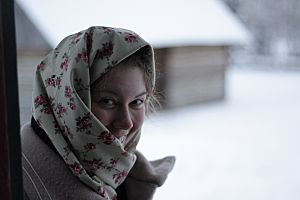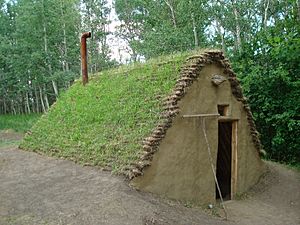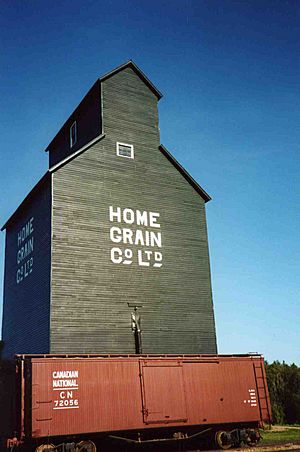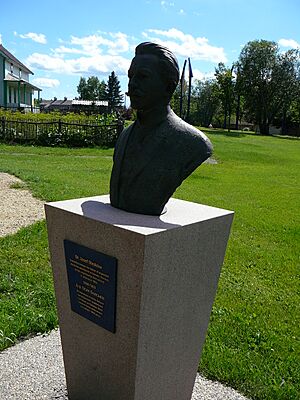Ukrainian Cultural Heritage Village facts for kids
 |
|
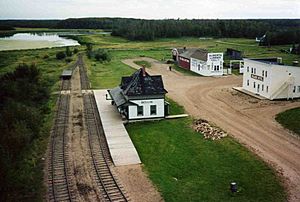 |
|
| Established | 1974 |
|---|---|
| Location | Lamont County, east of Elk Island National Park, Alberta, Canada |
| Type | open-air, living history |
Have you ever wished you could travel back in time? At the Ukrainian Cultural Heritage Village, you can! This special open-air museum in Alberta, Canada, is like a time machine that takes you back to the early 1900s. It shows what life was like for the first Ukrainian Canadian settlers who moved to this part of Canada between 1899 and 1930.
Instead of just looking at objects in glass cases, you get to walk through a real village from the past. The buildings are historic homes, farms, and shops that were moved from nearby towns and carefully restored. The best part is that actors in costumes walk around the village, pretending to be the people who lived and worked there long ago. They bring history to life right before your eyes!
The Village is located in Lamont County, just east of Elk Island National Park. It's open for visitors from the May long weekend until Labour Day each year.
Contents
A Trip Back in Time
The Ukrainian Cultural Heritage Village is a living history museum. This means it tries to be as realistic as possible. The costumed actors use a special technique called first-person interpretation. This means they stay "in character" the whole time you're there.
If you ask an actor a question, they will answer as if it is the year their building is set in, like 1928! For example, they won't know what a smartphone or the internet is. It might feel a little strange at first, but it helps you feel like you've really stepped into the past. It's a much more exciting way to learn about history than just reading about it in a book.
Exploring the Village's Buildings
The Village is set up to show you how life changed for Ukrainian settlers over time. It's divided into different areas, each showing a different part of their lives. The names of people and places are spelled the way they were back then.
First Homes in Canada
This area introduces you to the first families who came from regions in Europe called Galicia and Bukovyna. You can see the homes of three different families.
- The Pylypow House: Iwan Pylypow was one of the first people to encourage Ukrainians to move to Canada. This was his third house in Canada, showing how his life improved over time.
- The Hawreliak House: This large house belonged to a family from Bukovyna. By the 1920s, they were doing very well. Their house even had a special tank called a cistern to collect rainwater for the kitchen.
- The Yurko House: This family was also from Bukovyna, but they had Romanian roots. Their home shows the diversity of the people who settled in Alberta.
Life on the Farm
This section shows how farms grew and developed. It starts with the very first shelters and moves on to more established farmyards.
First Shelters
When immigrants first arrived, they often had to build temporary homes. One type was called a burdei, which was a shelter dug into the side of a hill. It was a simple but effective way to stay warm and safe while building a more permanent home.
Growing Farms
As families settled in, they built bigger houses, barns for their animals, and granaries to store grain. You can see different styles of buildings from both Galician and Bukovynian settlers. This shows how they adapted their building traditions to their new life in Canada. Later on, you can see how farms became more modern with sheds for new machines like threshing machines.
The Rural Community
Life wasn't just about farming. People also built communities where they could gather, shop, and worship. This part of the Village is set in the years 1925-1930. You can visit:
- A roadside shrine for prayer.
- The Luzan Grocery and Post Office, where people bought food and picked up their mail.
- Kiew Hall, a community hall where people held meetings, dances, and celebrations.
- Two different churches, showing the importance of faith to the settlers.
- A one-room schoolhouse, where children from all grades learned together.
- A working sawmill, which was used to cut logs into lumber for building.
The Town Site
As more people arrived, small towns began to pop up, often near a railway line. This area shows what a typical town looked like around 1930. It was a busy center for business and social life. Some of the buildings you can explore include:
- St. Vladimir's Church, which has beautiful paintings on the inside walls.
- A hardware store, a pool hall, and a general store.
- The Radway Post Office and Telephone Exchange, which connected the town to the outside world.
- A livery barn, where people could keep their horses while they were in town.
- The Bellis Train Station and a tall grain elevator, which were vital for shipping grain and goods.
- A blacksmith shop, where a smith would make and repair metal tools.
- The Hilliard Hotel, where visitors to the town could stay.
Monuments and Memorials
The Village also has several monuments that honor important people and events in Ukrainian Canadian history. These statues and memorials help us remember the challenges and achievements of the settlers. Some of them include:
- A monument to Joseph Olesków, who helped organize the migration to Canada.
- A statue of the famous Ukrainian writer Vasyl' Stefanyk.
- A cenotaph, or memorial, for Ukrainian Canadian soldiers.
- A cross to remember the Chornobyl Disaster in Ukraine.
- A memorial for Ukrainian Canadians who were held in internment camps during World War I.
See also
- Kalyna Country – an ecomuseum region in East Central Alberta, of which the Village is a part
- List of Canadian place names of Ukrainian origin – some of the places where the Village's buildings and machines are from are listed on this page (in the Alberta section)
- Narodny dim – community halls with a Ukrainian cultural emphasis concentrated in districts inhabited by Ukrainian Canadians across the Prairie provinces


